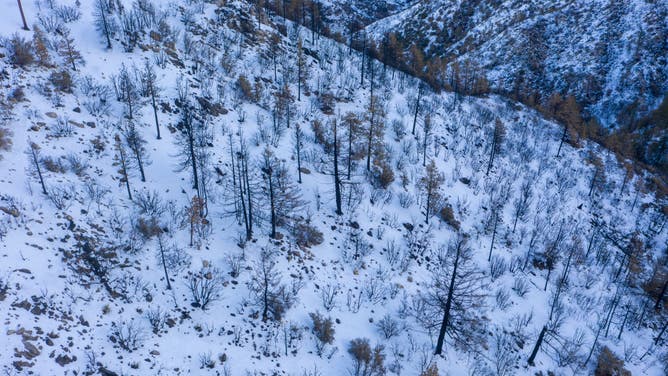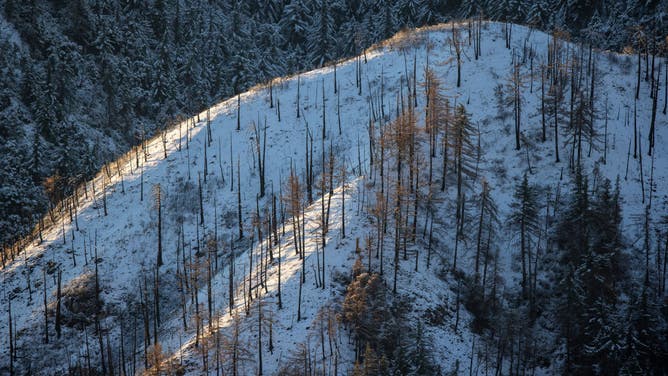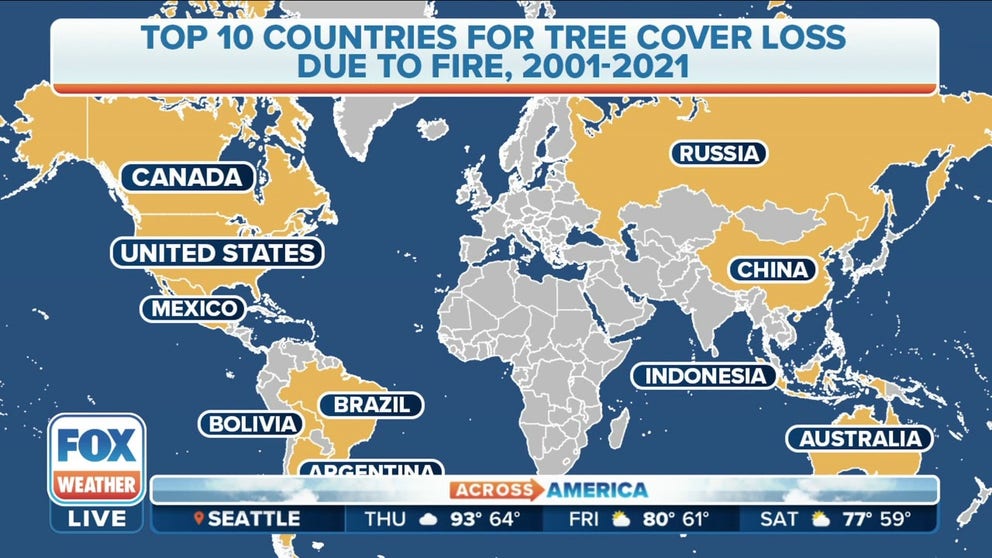Past wildfires still melting California's mountain snowpack years after flames doused, study finds
NOAA researchers found that the loss of tree canopy as wildfires in California reach higher elevations is leading to snow melting at much greater rates than average and wiping out snowpacks much sooner than usual.

AZUSA, CA - DECEMBER 31: In an aerial view from a drone, burned trees are seen after the first winter storm of the season drops snow on the 115,796-acre Bobcat Fire scar in the Angeles National Forest on December 31, 2020 near Azusa, California.
(David McNew / Getty Images)
Summer wildfires are reaching higher into the California mountains in recent years, and a new study finds the charred forests are having a dire effect on winter snowpacks long after the flames have been doused.
NOAA researchers found that the loss of tree canopy is leading to snow melting at much greater rates than average and wiping out snowpacks - a crucial ingredient to the region's water supply - sooner than usual.
Of particular interest that sparked the research were two weeks-long dry periods in California's mountains during the winters of 2012-2013 and 2020-2021. The latter winter came on the heels of two of the worst fire seasons in state history which featured a 10-fold increase in wildfires over the previous 20 years' average.
HOW WINTER'S ATMOSPHERIC RIVER STORMS COULD SUPERCHARGE CALIFORNIIA'S WILDFIRE SEASON
While both periods had similar amounts of snowpack before the dry spell and similar temperatures, researchers were stunned to find the more recent winter had 50% less snowpack in the fire-scarred region after the dry spell ended.

LA CANADA-FLINTRIDGE, CA - JANUARY 24: A burned forest is seen in the Angeles National Forest.
(David McNew / Getty Images)
When nature no longer throws shade…
How?
Researchers believe two main factors led to the accelerated melting of the snowpack. First, the charred trees were not providing any canopy for shade that keeps temperatures cooler on the ground. Increased exposure to sun meant a faster melt.
WIDESPREAD WESTERN WILDFIRES PLUS WINTER WEATHER: A DANGEROUS SETUP FOR DEADLY DEBRIS FLOWS
In addition, the burnt timber and vegetation shed black carbon onto the snow, decreasing the snow's ability to reflect incoming sunlight and instead, absorb more of its heat.

LAKE ARROWHEAD, CA - NOVEMBER 3: Snow gathers on the blackened earth under pines that burned in the Old Fire November 3, 2003 east of Lake Arrowhead, California.
(David McNew / Getty Images)
In some places, snow wasn't only melting faster in the spring, but beginning to melt in the middle of winter -- an alarming development in a state where about 33% of their water supply comes from the winter snowpack.
An earlier snowmelt can trigger a variety of unwanted challenges in controlling reservoir storage for managing city water supplies, hydroelectric power generation and providing enough water for farms and crops.
What's more, researchers say warming and drying summers and autumns increases strain on water demand and increases threat of wildfire activity.
Forests around world see major tree cover loss due to wildfires
Global Forest Watch research analyst James McCarthy tells FOX Weather that tree cover loss impacts wildlife and increases the risk of flooding after wildfires spread through an area.
"Current operational hydrologic models do not capture these landscape changes," researchers said. "This makes it difficult to forecast the timing and quantity of runoff from snowmelt in burned areas."
And it can be 10 years before a burn scar can recover.
HOW WILDFIRE BURN SCARS CAN HAVE LASTING IMPACTS
Thus, researchers stress additional resources are needed to factor in changes to potential snowpack due to recent wildfires "as both wildfire and dry spells will increase in frequency with climate warming," the study authors wrote.
